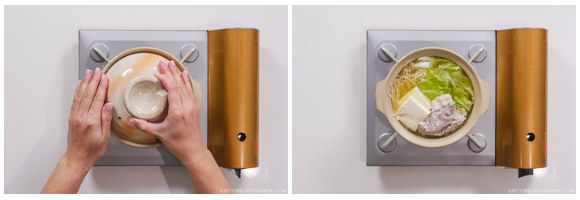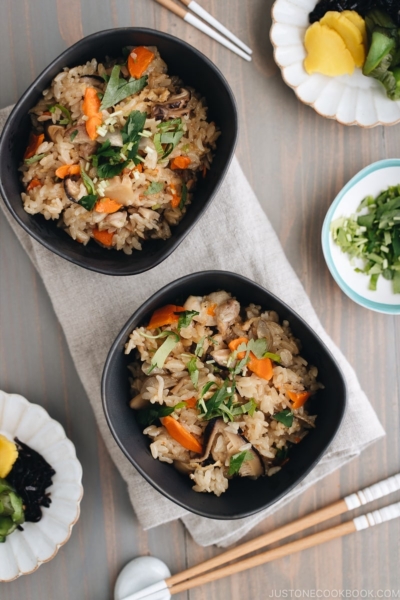Hot Pot for One is a fast, easy, and comforting meal to make at home. My recipe features tender pork belly simmered in a delicious and savory dashi stock with napa cabbage and enoki mushrooms. Inspired by the Japanese drama Midnight Diner.

The popular Japanese TV program called Shinya Shokudo (深夜食堂) or ’Midnight Diner: Tokyo Stories’ is now available on Netflix. The show features Japanese dishes that are more representative of home-cooked recipes than Japanese restaurant menu items in the US.
Since the drama doesn’t provide detailed ingredients and step-by-step instructions, I started to share these copycat recipes on my blog. Today’s recipe is Hot Pot for One, the Japanese title for this dish is Napa Cabbage and Pork Belly Hot Pot for One (白菜と豚バラの一人鍋).
Why We Should Make Hot Pot For One
Although you can make this recipe into two or four servings easily, I thought of some situations that would be suitable for enjoying a hot pot for one:
- Comforting late night meal for someone working/studying hard (Otsukaresama! You did good today!).
- Quick and easy yet fancy lunch for stay-at-home moms/dads and people working from home (No more leftovers!).
- Nutritious and easy home-cooked dinner for singles (Ditch takeout tonight!).
- Light meal for someone under the weather (Get well soon…).
- Separate meal for an elder family member (Eat well and enjoy!).
- Or simply, a huge fan of Midnight Diner and want to eat like that (including myself!).

Ingredient Choices for Hot Pot for One
There are many ingredients that you can use in this recipe:
- Meat (sliced pork/beef, chicken)
- Seafood (white fish, shrimp, squid, crab, clams, fish cakes)
- Tofu
- Leafy vegetables (napa cabbage, spinach, bok choy)
- Root vegetables (carrots, turnips, gobo, daikon radish)
- Mushrooms (shiitake, shimeji)
- Noodles (udon, vermicelli, konnyaku, cellophane)

3 Reasons to Get A Donabe (Japanese Earthenware Pot)
1. Good heat retention
Compared to the metal pot, donabe increases the temperature of the pot slowly and gently. Once the temperature is optimal and heat is reduced, it retains the heat well. Other great uses for donabe include cooking rice, as you can slowly cook the rice on lower heat and the rice will be cooked to perfection.
2. Beautiful design
The donabe pot looks beautiful at the dining table when you cook hot pot.
3. Looks delicious!
The food cooked in donabe is really delicious though I am not sure why. The delicate flavors for dishes like rice porridge (Okayu), hot pot, and Yudofu (hot tofu) are accentuated. There has been scientific studies done proving that using gentle heat to cook food in donabe brings out umami from the food (by measuring the amino acid amount).
You should also know Cons:
- Requires space to store
- Easy to chip
- Heavy
How To Season Donabe Before First Use
When you buy a donabe, you have to season it before you use it for the first time. Please read this post for the tutorial.

Enjoy Hot Pot For One!
We like to drizzle a bit of ponzu in our soup or on the side to dip the ingredients. How do you like your hot pot? Let me know in the comments below.

Wish to learn more about Japanese cooking? Sign up for our free newsletter to receive cooking tips & recipe updates! And stay in touch with me on Facebook, Pinterest, YouTube, and Instagram.

Hot Pot for One
For the Katsuo Dashi
- 2 cups water
- 1 cup katsuobushi (dried bonito flakes) (for vegan/vegetarian, make Vegan Dashi)
For the Hot Pot
- 2 leaves napa cabbage
- 4 slices pork belly (skip for vegan/vegetarian)
- 2 oz medium-firm tofu (momen dofu)
- 2 oz enoki mushrooms (¼ package)
- 2 tsp sake
- Gather all the ingredients.
To Make the Katsuo Dashi (Use Kombu Dashi for Vegan)
- Boil 2 cups water in a medium saucepan. When boiling, add 1 cup katsuobushi (dried bonito flakes).
- Cook for 15 seconds. Turn off the heat and let the katsuobushi infuse for 15 minutes. Strain the katsuobushi and repurpose it for another use. Set aside the Katsuo Dashi.
To Make the Hot Pot
- Cut 2 leaves napa cabbage into smaller pieces.
- Cut and discard the bottom of 2 oz enoki mushrooms. Cut 2 oz medium-firm tofu (momen dofu) into smaller ½-inch (1.3-cm) slices. Cut 4 slices pork belly in half or thirds.
- Place the ingredients in the donabe (earthenware pot) and pack nicely. Pour in the Katsuo Dashi and 2 tsp sake.
- Cover the lid and bring it to a simmer. Skim the foam and scum with a fine-mesh skimmer. Cook for 5 minutes and serve immediately with ponzu for dipping and shichimi togarashi (Japanese seven spice) if you like a spicy kick.















I was wondering if the midnight diner recipes are in any of your cookbooks (or just the blogs) thanks in advance
Hi Honey! Thank you very much for reading Nami’s post and trying her recipe!
There is only one Midnight diner recipe in her cookbooks. 😉
We hope this helps!
Hi Nami!
I was just curious – is it possible to use a dutch oven for this recipe? I do not have quick access to a Donabe, but I do have a 4.5qt dutch oven at home.
Thank you!
Hi Cate! Thank you very much for reading Nami’s post!
Yes, you can use a dutch oven for this recipe if that is the case.😉
Donabe is excellent for making soups, stews, and braised dishes. You can also use it for steaming, roasting, or cooking the most amazing rice you have ever had! So we highly recommend it if you can access it!🙂
Hey there! Can I ask what portable burner you used? I would really like to purchase a gas burner since I’m stuck in an apartment with a long electric stove.
Hi Cora, Nami uses this Iwatani brand: https://www.amazon.com/dp/B013U7AUA4/?ref=exp_justonecookbook_dp_vv_d.
We hope this helps!
I like to add in cloud-ear fungus,** preferably fresh stuff, in addition to the enoki mushrooms. In my view the enoki mushrooms are an essential part of this dish, really, in order to maintain the “clarity” and clean-ness of the recipe. Even bunapi-shimeji is not as preferred, even if that would be OK if enoki mushrooms are not on hand and one has a hankering for this soup.
Other substitutions I’ve used include fuzzy squash in place of the hakusai. Works well.
** NOT wood-ear fungus, which is coarser than is desired IMO in this delicate soup.
Hi Huiray! Thank you so much for sharing your detailed feedback and cooking experience! 🙂
Thanks for the kind words.
I’ve made other recipes from Japanese cooking dramas including this one as well as from Kodoku no Gurume. 🙂
What about recipes from the original Shinya Shokudo? What you post here are recipes from Midnight Diner: Tokyo Stories, which is really seasons 4 & 5 of Shinya Shokudo. I saw the original seasons 1-3 elsewhere, but they have recently been “cleaned up” and added on to Netflix, just in case you missed this new addition to their catalog. 🙂 One of my favorites from the original seasons is menchi katsu (original season 3 episode 1), for which I use your recipe on this site. Nice one!
One of the simplest and most attractive (to me) recipes from Kodoku no Gurume was/is “patan”, from that episode where Goro ended up in that Chinese-owned & operated “pork everything” restaurant in Yokohama (Season 3 episode 2). It’s a kicker of a dish, and simple in the extreme. After eating one, no vampires would dare approach you. Heh. Just visual observation enables one to make the dish. I do change it slightly in that I mix my chopped garlic (LOTS and LOTS of it, more than shown in the show) with the sesame oil then zap it in the microwave for 20 seconds – this mellows it out a bit – then toss it with rinsed & drained fresh yakisoba with a splash of soy sauce & top with chopped scallions. That’s it, that’s the entire dish. 🙂
Well, I just rewatched KnG S3E2…and besides the “patan” I was left LONGING for the wonderful pork innard dishes shown on the show and on the restaurant’s menu. 😀 Pork stomach, pork uterus, pork intestines, pork this-and-that, etc etc etc. Haven’t had those in a while, should get to creating them to be enjoyed again.
And the “patan” – heh, I just started peeling a couple heads of garlic to make a big “patan” dish for dinner. 🙂
One of the other “food items” in that same episode of “Midnight Diner: Tokyo Stories” from which the Hot Pot for One dish comes from [season 1 episode 7; which corresponds to season 4 episode 7 or episode 47 overall of Shinya Shokudo] is where the woman protagonist is urging her good-for-nothing nephew to have some of the croquettes she had just got, when she come upon and recognizes Chu, her former schoolmate, one of the regulars in the diner. These croquettes, a Japanese take on the food item, intrigued me – and was a reminder of their appearance here and there on the show in other episodes as well. You should draw people’s attention to this (and others) as well. 🙂
KOROKKE, that’s what they presumably are. I’ve made them and loved them. I used your recipe for them, thanks very much. To other folks reading, this is:
https://www.justonecookbook.com/korokke-croquette/
Hi Huiray! Thank you so much for all the feedback! 🙂 I’ll try to add more MD recipes in the future, but I haven’t had much time to watch… we’ll have unlimited recipes to share in the future!
Thank you for the kind words.
I made tonight another pot of this excellent dish – using Taiwan Bok Choy instead (台灣小白菜) which gives a very nice textural “look” to the dish when “bowled”, because of the much more curly greenery this vegetable has; which still basically tastes just like hakusai.
I also added some “Better than Bouillon” chicken base to the katsuobushi dashi. Very nice. (I do this sometimes in this dish) I also simmered the sliced pork belly in the stock for a while to properly soften the meat to “melt in your mouth” condition before I added the enoki mushrooms and chopped 台灣小白菜 and simmering for just a minute to let the veggies retain a “crunch”. (No cloud-ear fungus added in this prep)
Ponzu sauce as an accompaniment/dip.
Hi Huiray! Ah that sounds really good! Thanks for sharing your delicious meal with us! It made me hungry… 🙂
Hello
Have been making many of your recipes during this lockdown period. Thank you for your generosity in sharing your knowledge – it’s made Japanese food my new go to food choice (esp as a single person meal) and I’ve been telling friends to use this blog. I have a question on the an alternative if you don’t have a donabe – what do you suggest?
Hi Bernice! Thank you so much for recommending my site to your friends! You’re so kind!! If you don’t have a donabe, you can use a regular pot. If you use a heavy bottom pot, the heat goes around equally so that’s a plus, but if you don’t have it, just use a regular pot that fits ingredients. We Japanese think donabe makes it tastier and also retains heat well even though you turn off the heat and bring it to the table, etc. 🙂
Hello Nami! May I asked what size donabe is this? For one person? There are so many sizes available, and I get confused. Thank you! 🙂
Hi Ra! I recommend a 12 inch (30 cm) donabe for 4 servings. The single pot (1 serving) diameter is 6.5 inches (16.5cm) and can hold 2 cups (500 ml).
This is my go-to breakfast/lunch. Whatever piques my interest that day goes in the pot. The only difference is I don’t use any tofu. Leftover meat/poultry/fish is just fine. Frozen gyoza works. Instead of Napa cabbage, kimchi for a kick. Bored with just dashi – add miso.
But I always have a carrot in the mix.
The only downside is the donabe retains heat so well that you have to eat slowly to avoid scorching your tongue & palette.
So versatile a recipe it is.
As always, a pleasure to peruse your site.
Hi Al! Thank you so much for your kind words. I’m so happy to hear you like recipes from my site. 🙂 You can have a bowl too, to take out the food temporary before dipping. That’s what I usually do… I also can’t eat super hot food. 😀
Hello Nami! Have you seen the second season of “Midnight Diner” on Netflix? I’ve started watching it and thought about you trying to recreate some of Master’s dishes!
Hi Donna! Yes! We’re watching now and will start filming the recipes from the show soon! 😀 Hope all is well with you!
Looking forward to that! 😉
Hi Namiko,
Is there a reason why your 1 cup measurement is 480ml? Cos this feels like a lot for 1 cup, US measurement.
Thank you
Hi Vi! I apologize for the typo, it should be (2 cups = 480 ml). I removed the confusing “2 cups =” part from the recipe. Thanks so much for letting me know.
Hello! I just seasoned my nabe pot and tomorrow I’ll be attempting to cook with it!
Just a question – is it possible to substitute the dashi for konbu broth?
Thank you!
Hi Elena! Yes, you can use kombu dashi instead. Hope you enjoy the recipe! 🙂
Thank you for this recipe and opening the door to the world of Donabe cooking for me. I got mine a week ago and coked this dish tonight. It was everything that I was hoping for: simple, healthy, fresh, clean. I can’t wait to explore more recipes to do with this donabe. Thanks for the blog, really enjoy your work and your approach to cooking.
Hi Xavier! I’m so happy to hear that you enjoyed this recipe! It’s fun making hot pot. It’s easy to prepare (mostly chopping ingredients), lots of veggies, not so oily… and it’s comforting. We had hot pot last night and tonight we’re having different kind as well. 😀 Thank you for your kind comment!